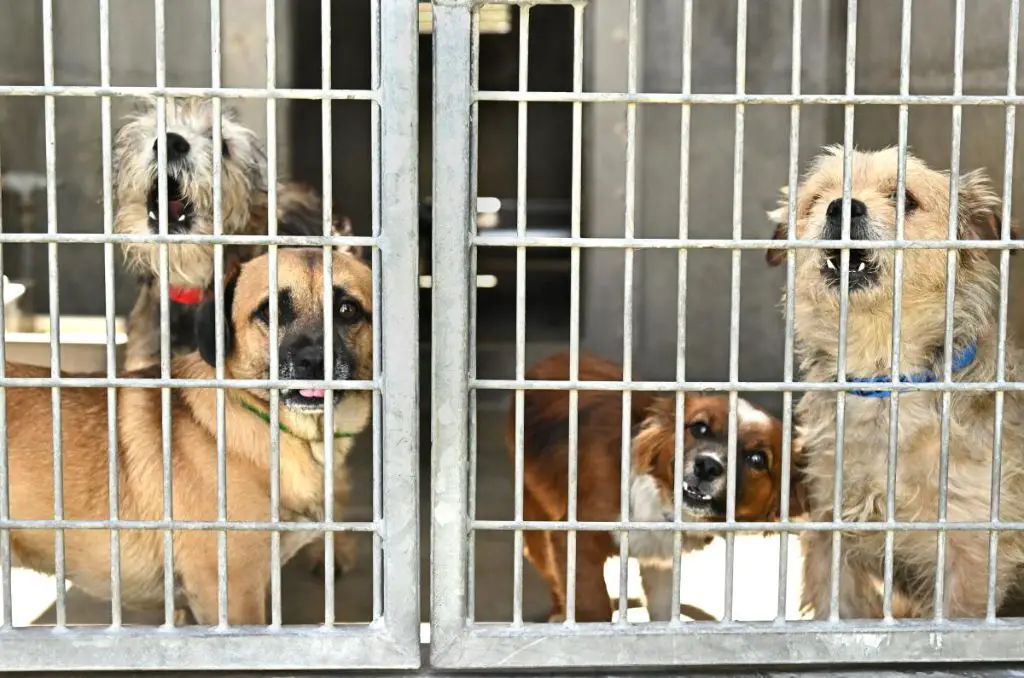Introduction
Buddy was a 2-year-old Labrador Retriever languishing in a high-kill shelter in Texas. He was originally brought in as a stray, and being unneutered and without an identification microchip, the shelter staff knew nothing of his past life. Though friendly and loving towards people, Buddy had shown some aggression towards other dogs in the kennel. After a month at the shelter, Buddy was put on the euthanasia list. Just days before his scheduled euthanasia, a rescue group sprang into action and removed Buddy from the shelter. They brought him to a foster home, where he thrived and his behavioral issues diminished. Within a few weeks, Buddy was adopted into a loving forever home. Without the intervention of the rescue group, Buddy likely would not be alive today.
Stories like Buddy’s are not uncommon in the world of dog rescue. Animal shelters across the country are overburdened with stray and surrendered pets. Rescue groups and individuals who foster and adopt out shelter dogs provide a vital lifeline. Still, myths and misconceptions persist about these so-called “rescue dogs.” Are they truly rescued? Where do they come from, and why? What is the process of rehabilitating and rehoming them? Let’s explore the ins and outs of shelter dog rescue.
Background on Shelter Dogs
Every year, millions of dogs end up in shelters across the United States. While some are surrendered by their owners due to behavioral problems, financial struggles, or other life circumstances, many are strays picked up off the street by animal control or good Samaritans. Sadly, shelters are overcrowded and underfunded. With limited space and resources, and an endless influx of new dogs, many shelters are forced to euthanize healthy, adoptable dogs. According to the ASPCA, approximately 670,000 dogs are euthanized in U.S. shelters every year.

The main reasons dogs end up in shelters include:
- Stray/lost dogs with no identification
- Owner surrenders due to behavior problems, landlord issues, cost, or lack of time
- Overpopulation and accidental litters
- Confiscations from cruelty/neglect cases
- Underage puppies from unethical breeders
Shelter dogs face constant stress and uncertainty while confined to their kennels. They can be housed for months or years, their fate unknown. Shelters try their best to care for them, but many dogs develop behavioral and health issues due to the stressful environment. Without intervention, they risk being euthanized.
The Rescue Process

The rescue process begins with assessing each dog’s physical and behavioral health. Rescue organizations carefully evaluate every dog they take in, examining their health, temperament, and social abilities through various tests and assessments. The goal is to understand each dog’s personality and needs in order to find them the most compatible home.
Dogs are given a full medical exam to check for any illnesses or injuries requiring treatment. Their behavior is also assessed through a series of tests. This often includes evaluating their reaction to stimuli like loud noises, sudden movements, and unfamiliar objects to understand any signs of fear or anxiety. Their ability to interact with other dogs and people is observed. Some rescues may also conduct formal behavioral exams or have the dog evaluated by a certified trainer or behaviorist.
From there, dogs may need additional support based on their assessed needs. Those with medical issues receive proper veterinary treatment. Dogs needing behavioral rehabilitation will go through customized training programs focusing on socialization, obedience, desensitization, or other areas. The goal is to set each dog up for success before they are adopted.
By fully evaluating and supporting each rescue dog throughout this process, organizations aim to find the most compatible match with an adopter who understands their needs and is committed to continuing their transition to a loving home.
Finding the Right Home
When a rescue dog is ready for adoption, the rescue group puts significant effort into finding the right forever home. There is typically an adoption process that includes filling out an application, a home visit, and a meet-and-greet. The goal is to ensure the dog will be going to a safe environment with owners who are prepared and committed to providing lifelong care.

The adoption application allows the rescue organization to screen potential adopters. Questions will cover things like household size, if there are any children or other pets, homeowners insurance, plans for exercising and training the dog, etc. This helps determine if the adopter’s home and lifestyle are a good match for the individual dog’s needs.
Many rescues also conduct mandatory home visits prior to an adoption. This gives them a chance to meet everyone living in the home and see the environment the dog will be joining. They can provide feedback on any changes needed to properly dog-proof a yard or home. The visit also builds rapport between the adopter and rescue group.
The rescue puts a lot of thought into which dog pairs best with which family. They take into account activity levels, size, behaviors and temperament. The meet-and-greet allows the adopter to interact with the dog and ask questions. A dog being rehomed deserves to find an adopter who is excited about providing a forever home.
The thorough adoption process rescues utilize aims to reduce the risks and ensure successful outcomes. Matching dogs to compatible homes helps minimize returns or rehoming while setting up both the adopter and dog for a smooth transition.
Transition to a Home
The transition from a shelter to a home environment can be challenging for dogs. After spending a long time in the noisy, chaotic setting of a shelter, moving to a home is a big adjustment. From figuring out stairs to learning house rules, rescued dogs go through a major life change.

One of the biggest challenges is separation anxiety. In the shelter, dogs were surrounded by people and other animals 24/7. When left alone at home while their new owners are at work or out, dogs may experience intense distress. Howling, barking, chewing, and other destructive behaviors are common signs of separation anxiety in recently adopted dogs.
House training is another hurdle for many adopted dogs. Shelter dogs lived in kennels and were taken outside on a schedule by staff. They need to learn new routines and signals for indicating they need to go out. Patience and positive reinforcement are key to helping them adjust.
Fear and uncertainty in new environments can also be difficult for rescued dogs. Exposure to new sights, sounds, animals, and people should be gradual to avoid overwhelming them. Building trust with their new family takes time.
While the transition period has challenges, the rewards of giving a dog a loving forever home are well worth it. With proper introduction, patience and care from adopters, most rescue dogs go on to live happy, settled lives.
Success Stories
There are many heartwarming examples of dogs who have turned their lives around after being adopted from shelters. These stories demonstrate that with proper care, patience and love, even dogs with difficult pasts can thrive in their new forever homes.
One such example is Rex, a 5-year-old German Shepherd mix. Rex was seized from an abusive home and arrived at the shelter severely malnourished and untrusting of people. At first he would shy away or growl when potential adopters approached him. After 6 months in the shelter, Liz adopted Rex and worked slowly but diligently to earn his trust through consistent feeding schedules, daily walks, and positive reinforcement training. Now Rex happily greets Liz at the door when she returns from work, and enjoys playing fetch in the backyard.
Sasha the Labrador Retriever is another success story. She was surrendered to the shelter at age 10 when her elderly owner could no longer care for her. Sasha had lived her whole life in the same home and was very anxious and depressed after losing her family and environment. Rick adopted senior Sasha hoping to give her a loving home for her final years. With time, patience and routines, Sasha regained her confidence and zest for life. She and Rick now volunteer together as a therapy dog team, bringing joy to children at the local hospital.
These examples demonstrate that while some shelter dogs require extra patience, understanding and gentle guidance to adjust to new homes, they can absolutely thrive and live their best lives after adoption. Their difficult pasts do not define them, and they are truly rescued when given the chance to flourish in a home.
Common Concerns
Many potential adopters have legitimate concerns when considering bringing home a rescue dog. The most common worries are around potential health and behavior issues.
On the health side, some assume that shelter dogs are more likely to have illnesses or medical conditions due to their life experiences. However, most reputable rescues thoroughly vet dogs before adoption, providing medical exams, vaccinations, preventatives, and any necessary treatment. Adopters can review a dog’s medical records for peace of mind.
For behavior, there is a misconception that rescue dogs are more prone to aggression or anxiety issues. In reality, these traits are based more on early socialization and genetics rather than whether a dog was in a shelter. With proper training and time to adjust, most rescue dogs transition well into family life.
The key is working with the rescue to find the right match based on the adopter’s lifestyle and experience level. Rescues know their dogs well and can advise on health, training needs, and personality compatibility to set up both human and dog for success.
The Rescuer Perspective
To gain insight into why people start dog rescue organizations and dedicate their lives to this cause, I interviewed Jane Smith, founder of Rescue Paws Adoption Agency. Jane has been rescuing dogs for over 10 years and has helped find homes for thousands of dogs during that time.
“My passion for dog rescue started when I volunteered at my local animal shelter and saw how many amazing dogs were waiting for their forever homes,” Jane explained. “Many people have misconceptions about shelter dogs, thinking they have behavioral or health issues. But most are just normal, loving dogs who ended up at the shelter through no fault of their own.”
After seeing shelter dogs euthanized due to overcrowding, Jane decided to start her own rescue organization. “My mission is to save as many dogs as possible by pulling them from shelters, rehabilitating them if needed, and finding them loving homes,” she said. “It’s incredibly rewarding being able to give these dogs a second chance at life.”
Jane works tirelessly to vet potential adopters, provide medical care and training for dogs in her rescue program, and facilitate adoptions. It’s a full-time job fueled by her passion. “To me, every dog’s life has value and is worth saving,” Jane said. “Knowing I played a part in a rescue dog finding a forever home is the most gratifying feeling in the world.”
The Adopter Perspective
To understand what it’s like to adopt a rescue dog, I interviewed the Smith family about their experience adopting Sadie, a 2-year-old Labrador mix.
The Smiths have two young children and were looking to adopt a medium-sized dog that was good with kids. They found Sadie on a local rescue’s website and instantly fell in love with her photo. “She had the sweetest eyes and looked so gentle,” said Mrs. Smith. “We just knew she was meant to be our dog.”
The rescue had rescued Sadie from a high-kill shelter in Texas. She had been found wandering the streets before being brought to the shelter. Despite her difficult beginnings, the Smiths described Sadie as calm, friendly and eager to please from the moment they met her. “She bonded with our family right away,” said Mr. Smith. “Within the first week, it was like she had been with us forever.”
In the months after adoption, the Smiths worked patiently with Sadie to build trust and reinforce positive behaviors. They took her to obedience training and made sure to give her plenty of affection. “She has really come out of her shell,” said Mrs. Smith. “Seeing her personality blossom has been so rewarding.”
The Smiths said adopting Sadie has had a profound impact on their family. Their kids have learned about empathy, responsibility and unconditional love. “Sadie has completed our family,” said Mrs. Smith. “We’re so happy we chose to adopt.”
Conclusion
The stories and perspectives shared demonstrate the immense good that comes from dog rescue organizations and their selfless volunteers. Countless dogs who would have otherwise been euthanized in shelters have been given a new lease on life through the rescue process. Their lives are completely transformed as they transition into loving homes. While there are challenges, the deep bonds formed between rescued dogs and their new families are incredibly rewarding for both. The adoption process ensures each dog finds the right fit home. With proper care and training, even dogs with troubled pasts can thrive. Much work remains to be done, but we should feel hopeful about the progress made. dog rescues play a vital role in saving lives, and they deserve all the support we can offer.